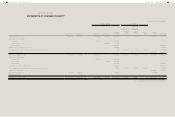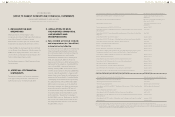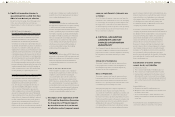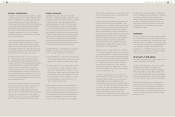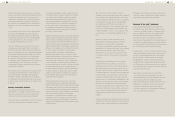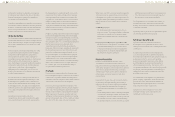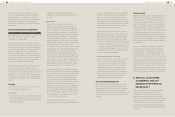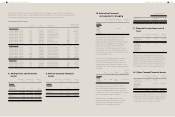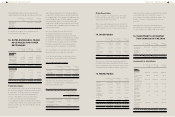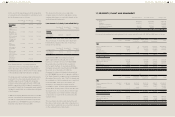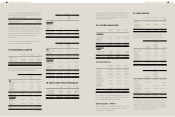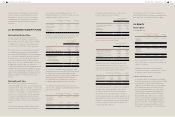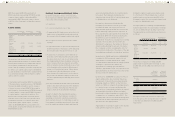HTC 2013 Annual Report Download - page 98
Download and view the complete annual report
Please find page 98 of the 2013 HTC annual report below. You can navigate through the pages in the report by either clicking on the pages listed below, or by using the keyword search tool below to find specific information within the annual report.
FINANCIAL INFORMATION FINANCIAL INFORMATION
192 193
by delivery of such unquoted equity investments
are measured at cost less any identified
impairment losses at the end of each reporting
period and are recognized in a separate line item
as financial assets carried at cost. The financial
assets are remeasured at fair value if they can be
reliably measured at fair value in a subsequent
period. The difference between carrying amount
and fair value is recognized in profit or loss or
other comprehensive income on financial assets.
4. Loans and receivables
Loans and receivables are non-derivative financial
assets with fixed or determinable payments that
are not quoted in an active market. Loans and
receivables (including trade receivables, cash and
cash equivalent, other current financial assets,
and other receivable) are measured at amortized
cost using the effective interest method, less
any impairment. Interest income is recognized
by applying the effective interest rate, except
for short-term receivables when the effect of
discounting is immaterial.
b. Impairment of financial assets
Financial assets, other than those at FVTPL, are
assessed for indicators of impairment at the end
of each reporting period. Financial assets are
considered to be impaired when there is objective
evidence that, as a result of one or more events
that occurred after the initial recognition of the
financial asset, the estimated future cash flows of
the investment have been affected.
For certain categories of financial assets, such as
trade receivables and other receivables, assets are
assessed for impairment on a collective basis even if
they were assessed not to be impaired individually.
Objective evidence of impairment for a portfolio
of receivables could include the Company's past
experience of collecting payments, an increase in
the number of delayed payments in the portfolio
past the average credit period, as well as observable
changes in national or local economic conditions
that correlate with default on receivables.
The effective interest method is a method
of calculating the amortized cost of a debt
instrument and of allocating interest income
over the relevant period. The effective interest
rate is the rate that exactly discounts estimated
future cash receipts (including all fees and points
paid or received that form an integral part of the
effective interest rate, transaction costs and other
premiums or discounts) through the expected
life of the debt instrument, or, where appropriate,
a shorter period, to the net carrying amount on
initial recognition.
3. AFS financial assets
AFS financial assets are non-derivatives that are
either designated as AFS or are not classified
as (i) loans and receivables, (ii) held-to-maturity
investments or (iii) financial assets at FVTPL.
Fair value is determined in the manner described
in Note 32.
Changes in the carrying amount of AFS
monetary financial assets relating to changes
in foreign currency exchange rates (see below),
interest income calculated using the effective
interest method and dividends on AFS equity
investments are recognized in profit or loss.
Other changes in the carrying amount of
AFS financial assets are recognized in other
comprehensive income and accumulated
under the heading of investments revaluation
reserve. When the investment is disposed of
or is determined to be impaired, the cumulative
gain or loss that previously accumulated in the
investments revaluation reserve is reclassified to
profit or loss.
Dividends on AFS equity instruments are
recognized in profit or loss when the Company's
right to receive the dividends is established.
AFS equity investments that do not have a listed
market price in an active market and whose
fair value cannot be reliably measured and
derivatives that are linked to and must be settled
a. Measurement category
Financial assets are classified into the following
specified categories: Financial assets at fair
value through profit or loss ("FVTPL"), held-to-
maturity investments, available-for-sale financial
assets ("AFS") and loans and receivables. The
classification depends on the nature and purpose
of the financial assets and is determined at the time
of initial recognition. All regular way purchases
or sales of financial assets are recognized and
derecognized on a trade date basis. Regular
way purchases or sales are purchases or sales
of financial assets that require delivery of assets
within the time frame established by regulation or
convention in the marketplace.
1. Financial assets at FVTPL
Financial assets are classified as at FVTPL when
the financial asset is either held for trading or it is
designated as at FVTPL.
A financial asset is classified as held for trading if:
‧ It has been acquired principally for the purpose
of selling it in the near term; or
‧ On initial recognition it is part of a portfolio
of identified financial instruments that the
Company manages together and has a recent
actual pattern of short-term profit-taking; or
‧ It is a derivative that is not designated and
effective as a hedging instrument.
A financial asset other than a financial asset held
for trading may be designated as at FVTPL upon
initial recognition when doing so results in more
relevant information and if:
‧ Such designation eliminates or significantly
reduces a measurement or recognition
inconsistency that would otherwise arise; or
‧ The financial asset forms part of a group of
financial assets or financial liabilities or both,
which is managed and its performance is
evaluated on a fair value basis, in accordance
with the Company's documented risk
management or investment strategy, and
information about the grouping is provided
internally on that basis.
In addition, if a contract contains one or more
embedded derivatives, the entire combined
contract (asset or liability) can be designated as
at FVTPL.
Financial assets at FVTPL are stated at fair value,
with any gains or losses arising on remeasurement
recognized in profit or loss. The net gain or loss
recognized in profit or loss incorporates any
dividend or interest earned on the financial asset
and is included in the 'other gains and losses'
line item. Fair value is determined in the manner
described in Note 32.
Investments in equity instruments under financial
assets at FVTPL that do not have a listed market
price in an active market and whose fair value
cannot be reliably measured and derivatives that
are linked to and must be settled by delivery
of such unquoted equity instruments are
subsequently measured at cost less any identified
impairment loss at the end of each reporting
period and are recognized in a separate line item
as financial assets carried at cost. The financial
assets are remeasured at fair value if they can be
reliably measured at fair value in a subsequent
period. The difference between the carrying
amount and the fair value is recognized in profit
or loss.
2. Held-to-maturity investments
Held-to-maturity investments are non-derivative
financial assets with fixed or determinable
payments and fixed maturity dates that the
Company has the positive intent and ability
to hold to maturity other than those that the
entity upon initial recognition designates as at
fair value through profit or loss, or designates as
available for sale, or meet the definition of loans
and receivables. Corporate bonds above specific
credit ratings and the Company has positive
intent and ability to hold to maturity, are classified
as held-to-maturity investments.





